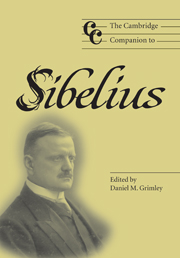Book contents
- Frontmatter
- Introduction
- Part I Forging a voice: perspectives on Sibelius's biography
- Part II Musical works
- Part III Influence and reception
- 10 Sub umbra Sibelii: Sibelius and his successors
- 11 Sibelius and Germany: Wahrhaftigkeit beyond Allnatur
- 12 Sibelius in Britain
- 13 Sibelius and contemporary music
- Part IV Interpreting Sibelius
- Notes
- Select bibliography
- Index of names and works
10 - Sub umbra Sibelii: Sibelius and his successors
from Part III - Influence and reception
Published online by Cambridge University Press: 28 September 2011
- Frontmatter
- Introduction
- Part I Forging a voice: perspectives on Sibelius's biography
- Part II Musical works
- Part III Influence and reception
- 10 Sub umbra Sibelii: Sibelius and his successors
- 11 Sibelius and Germany: Wahrhaftigkeit beyond Allnatur
- 12 Sibelius in Britain
- 13 Sibelius and contemporary music
- Part IV Interpreting Sibelius
- Notes
- Select bibliography
- Index of names and works
Summary
It is difficult to establish who was the first to mention ‘Sibelius's shadow’. The idea pops up in the 1920s at the latest. In an essay on ‘the youngest Finnish music’ from 1928, the composer Ernest Pingoud (1887–1942) refers to the ‘reappraisal of certain values’ during the First World War, notably to the ‘bankruptcy of Romanticism’ in the field of aesthetics.
Sibelius's output, cherished and tended by reverent hands, did not lose a tad of its value; on the contrary, it secured an officially-sanctioned eternal value and still flourishes in all its beauty. A new phenomenon, nevertheless, showed up: the mountainous overall shape of Sibelius's output came to be seen in a new light, or perhaps from a different perspective, and where its shadow had once fallen, new curious searchlights began to play their games. The consequences did not fail to reveal themselves, and new life emerged: new Finnish music, more or less independent from Sibelius, was born.
Pingoud was of Russian origin and had emigrated to Finland from St Petersburg in 1918, in the aftermath of the Russian Revolution. Although well integrated into the society of his patrie choisie ten years later, he remained an outsider in one important respect. Nationalism, the fundamental generating force in Finnish culture at the turn of the century, was none of his concern. He sympathised with it from the outside, as revealed in an article on Sibelius from 1909 in which he described the tone poem Finlandia, ‘the most national of Sibelius's works’, as ‘radiating a deep sorrow for his enslaved fatherland’.
- Type
- Chapter
- Information
- The Cambridge Companion to Sibelius , pp. 155 - 168Publisher: Cambridge University PressPrint publication year: 2004
- 1
- Cited by

